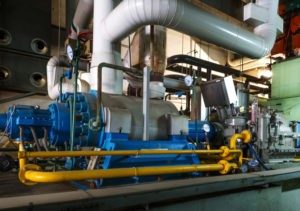Written by: Michael McCann
While power plants are vital to the operation of many facilities, schools, and campuses throughout New England, they were also a major source of asbestos exposure to power plant workers through the 1980’s. At a typical multi-building facility, the power plant was the building that generated steam to heat the other buildings in the facility. This was a common design for manufacturing facilities and college campuses that were made up of multiple buildings. Back in the 20th century, most of these power plants utilized dozens upon dozens of asbestos-containing products. What types of asbestos-containing products were used in these power plants?
First, the biggest piece of equipment in these power plants were the boilers that generated the steam for the rest of the facility. Large, steam-generating boilers utilized many different asbestos-containing components, including insulation, refractory material, and gaskets. Insulation and refractory material needed to be replaced periodically throughout the lifetime of the boiler. Repairing these materials could expose the power plant worker to hazardous asbestos dust.
The gaskets on these large boilers were found in various places. The biggest gasket went around the boiler door. This gasket had to be removed and replaced each time the boiler door was opened. Gaskets were also used around the other manways and handholes on the boiler. Manways were other openings on the boiler that would allow a person to enter the boiler to inspect or repair it. Each time these manways were opened, the gasket needed to be replaced. Handholes were smaller openings on the boiler that allowed for inspection of internal components of the boiler, by sticking in a hand or your head to view the inside of the boiler. These handhole gaskets also had to be replaced each time the handhole was opened. The removing and replacing of these gaskets would create hazardous airborne asbestos dust.

Boilers were certainly not the only products that exposed power plant workers to asbestos. These power plants needed many more pieces of equipment to operate efficiently. This equipment included pumps, valves, steam traps, heat exchangers, and various others types of products. Most of these pieces of equipment used asbestos-containing gaskets and packing material through the 1980s. These pieces of equipment needed to be maintained on a regular basis, and replacing the gaskets and packing on these pieces of equipment would create hazardous airborne asbestos dust.
While a lot of the power plants in Massachusetts that operated during the 20th century are no longer in operation, many are still active today. Our office has handled cases arising from asbestos exposure at a number of power plants in the area, some of those include:
- Phillips Andover Academy: Andover, MA
- Pilgrim Nuclear Power Station: Plymouth, MA
- Bird & Son: E. Walpole, MA
- Dennison Manufacturing: Framingham, MA
- Harvard University: Cambridge, MA
- MIT: Cambridge, MA
- Boston Edison: L Street Station, Edgar Station, and Mystic Station
- Northeastern University: Boston, MA
- Holy Cross University: Worcester, MA
- Boston College: Chestnut Hill, MA
- Brooks School: North Andover, MA
- Groton School: Groton, MA
If you or a loved one has been diagnosed with an asbestos-related illness like mesothelioma or lung cancer, and would like to know more about your rights, please call us for a free, confidential consultation at (617) 451-9191.